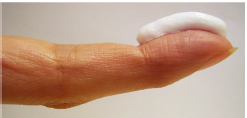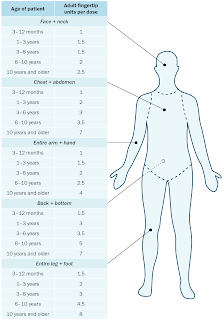Topical Corticosteroids
Introduction
Topical corticosteroids have a major role in the management of many skin diseases.
- They exert anti-inflammatory, antimitotic and immunosuppressive effects through a variety of mechanisms.
Potency
The selection often depends, to some extent, upon the severity, site and the patient's age.
# The potency classification of topical corticosteroid above is extracted from Australian Medicines Handbook, which potency estimate is based on vasoconstrictive ability, inhibition and potential for causing adverse effects. If you read United States reference (such as Lexicomp), topical corticosteroids can be classified into 7 groups according to potency.
NOTE: Topical corticosteroids range in potency from hydrocortisone (least potent) to Eumovate (clobetasone), Betnovate (betamethasone) or Elomate (mometasone) and Dermovate (clobetasol; most potent).
Application
Most topical corticosteroids can be applied twice daily, except topical mometasone which should be applied once daily only.- In general, it is best to be used for as short period as possible.
- However, being too cautious about using topical corticosteroids can result in inadequate treatment of the skin condition, resulting in stronger drugs (e.g. oral drugs) being required for a longer time.
Fingertip units is a simple way on how much the amount of topical corticosteroid to be applied.
- One fingertip unit is the amount of cream or ointment, squeezed out of a tube (with a standard 5 mm nozzle), from the tip of an adult’s index finger to the first crease.
- One fingertip unit (approximately 500 mg) is generally enough to cover an area twice the size of a flat adult hand (with the fingers together).
Adverse Effects
Topical corticosteroids are safer than systemic glucocorticoids. Nevertheless, cutaneous and systemic side effects can occur, particularly with superpotent and potent drugs or extensive use of lower-potency agents with or without occlusion.
- Cutaneous atrophy (skin thinning), telangiectasias, and striae are potential adverse effects of topical corticosteroid therapy and are more likely to occur with the use of higher-potency agents. In general, the use of super high-potency topical corticosteroids should be restricted to highly inflammatory dermatoses on the scalp, trunk, or extremities.
- Other cutaneous side effects of topical corticosteroids include purpura, changes in pigmentation, and hypertrichosis
- Hypothalamic-pituitary axis suppression may occur with prolonged use of high-potency corticosteroids, application to highly permeable areas, treatment of large areas, occlusion, and impaired skin barrier. Hyperglycaemia and unmasking of latent diabetes mellitus can also occur.
To reduce adverse effects of topical corticosteroids during treatment of chronic dermatoses, they may be used.
- To treat exacerbations only
- 2 or 3 times a week or on 2 consecutive days/week to maintain remission
- In combination with other agents
- Continuously, after initial response, using a low-potency product.
It is unclear whether tachyphylaxis (loss of effectiveness with continued use) actually occurs with topical corticosteroids or whether it reflects decreased use over time.



Comments
Post a Comment